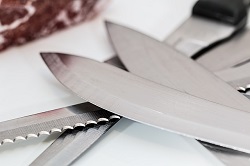
What is SS Stainless steel, its Types, and Composition?
Stainless steel is an alloy that contains iron, relatively little carbon, minimum of 10.5% chromium, and up to 30% nickel. Although they are typically 18% chromium and 8% nickel. For increased corrosion resistance or for manufacturing requirements in specific applications, chromium can be increased and other elements such as manganese, aluminum, titanium, and molybdenum can be added as required.

Stainless steels are sometimes referred to as corrosion-resistant steels. The word stainless can suggest that it does not stain. It does not mean that it does not stain in all environments, but less tarnished and more resistant to corrosive attack compared to steels with less than 10.5% chromium.
Does stainless steel resist corrosion?
Chromium [main element in stainless steels] more than 10.5% forms a tough protective film of refractory oxide on any exposed layer, which is a rust inhibitor. This relatively impenetrable film is believed to be self-produced, healing, or self-restoration. It will fix itself when it breaks by re-exposure to an oxidizing agent such as air or nitric acid.
Types of stainless steel
Stainless steels are grouped according to their metallurgical composition when cool at high temperatures. They are four basic types. The recognized stainless steels are:
• Duplex
• Austenitic
• Ferritic
• Martensitic
Duplex Stainless Steel
The duplex has a composition of nearly equal amounts of ferrite and austenitic. Chromium content varies from 18% to 28% and nickel content from 4.5% to 8%. Most grades also contain molybdenum.
Features:
- High resistance to stress corrosion cracking
- Higher level of inactivity
- Good welding and formability
- Higher tensile and yield strength than austenitic and ferritic grades
Austenitic stainless steel
[301, 304, 304L, 316, 316L 321, 310];
The basic composition of austenitic stainless steel is 18% chromium and 8% Nickel. Austenitic grades are the most widely used and account for the most common type 304 with over 70% of production. The name comes from its stable metallurgical structure at room temperature, which is an Austenitic single phase.
Austenitic stainless steels have the following characteristics:
• Can be strengthened by cold working [up to 4 times]
• easy to weld
• High flexibility
• Good corrosion resistance
• Suitable for high temperature [eg. 310 to 1100°C]
• Suitable for low temperatures [including cryogenic applications]
• is not magnetic
Ferritic stainless steel
[409, 430, 3CR12]
These are nickel-free stainless steel. Chromium content from 12%-18%, but lower carbon content.
They derive their name from the ferritic metallurgical structure that is Stable at room temperature.
Compared to austenitic stainless steels, ferritic stainless steels have the following features;
• less expensive
• Low resistance to corrosion
• Can be soldered, but requires more care
• Forms easily [folded, sliced, etc.]
• Moderately high temperature [430 to 800 °C]
• Cold working results in a slight increase in strength [up to 50%]
• Superior resistance to stress corrosion cracking
• is magnetic
Martensitic stainless steel
These stainless steels are alloys of iron, chromium [12 to 18%], and carbon. These stainless steels can be hardened by heat treatment. this type of Stainless steel is used where high mechanical resistance is combined
Corrosion resistance is required [eg. knife]
What is the composition of stainless steel?
Stainless steel is an alloy of iron and stainless steel is the composition of 72% Iron (Fe), 17-19% of chromium (Cr), and 7-9% of Nickel (Ne) along with Silicon (Si), Carbon (C), and manganese (Mn).
What are 3 main categories of stainless steel?
Austenitic stainless steel
Ferritic stainless steel
Duplex Stainless Steel
Martensitic stainless steel
Is stainless steel an alloy?
Stainless steel is an alloy that contains iron, relatively little carbon, minimum of 10.5% chromium, and up to 30% nickel. Although they are typically 18% chromium and 8% nickel.
Also read about Non Ferrous Metals
